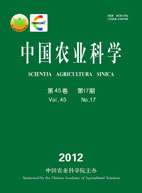-
Statistical Analysis of Methane Emission from Rice Fields in China and the Driving Factors
- WEI Hai-苹, SUN Wen-Juan, HUANG Yao
-
Scientia Agricultura Sinica. 2012, 45(17):
3531-3540.
doi:10.3864/j.issn.0578-1752.2012.17.009
-
 Abstract
(
888 )
Abstract
(
888 )
 PDF (515KB)
(
1384
)
PDF (515KB)
(
1384
)
 Save
Save
-
References |
Related Articles |
Metrics
【Objective】 The objectives of this study are to address the spatial characteristics of methane (CH4) emission from rice fields in China and to quantify the relationship between CH4 emission and driving factors associated with environment and field management in different rice cropping systems based on the data extracted from published papers.【Method】By searching literature databases, 111 articles published since 1987 were obtained that related to the field measurements of CH4 emission in different regions. A total of 495 datasets of the seasonal amount of CH4 emission or the mean flux of CH4 emission over a growing season measured at 67 sites were extracted from these articles. ANOVA, correlation analysis and stepwise regression were used to investigate the spatial characteristics of CH4 emission and driving factors. 【Result】The mean and standard error of CH4 emission from single rice, early-rice and late-rice cropping system were (383.5±31.1), (234.3±16.80) and (361.8±25.0) kg•hm-2, respectively. Methane emission from the single rice in southwest China was the highest, approximately being 1.3, 1.2 and 3.3 times higher than those from north, central and northeast China. In double rice cropping system, CH4 emission from the early- and the late-rice in central China was approximately 160% and 90% higher than those in south China (Guangxi and Guangdong Provinces). There is a significant positive correlation between CH4 emission and the input of organic carbon, while CH4 emission was found to be negatively correlated with the rate of synthetic nitrogen application and soil pH. CH4 emission from the single rice system declined with increasing latitude, longitude and soil total nitrogen. By contrast, CH4 emission increased from south to north in the double rice cropping system, and increased with soil total nitrogen in the late-rice system. The spatial variability in seasonal amount of CH4 emission for the single rice can be well quantitatively described by a linear combination of six variables (R2=0.72, P=0.000, n=241), including latitude, soil parameters of C﹕N ratio and sand fraction, irrigation regime, rates of organic carbon input and synthetic nitrogen application. For the early-rice, the spatial variability in CH4 emission was quantitatively determined by a linear combination of five variables (R2=0.35, P=0.000, n=121), including soil parameters of C﹕N ratio and sand fraction, mean temperature from rice transplanting to heading, irrigation regime and rate of organic carbon input. A linear combination of six variables, including latitude, soil parameters of C﹕N ratio, clay fraction and pH, mean temperature over the rice growing season and rate of organic carbon input, determined the spatial variability in CH4 emission for the late-rice system (R2=0.47, P=0.000, n=133).【Conclusion】The seasonal amount of CH4 emission per unit area from rice field ranks in a descent order of single rice, late-rice and early-rice in China, but no significant difference existed between the single and late-rice. CH4 emission in southwest China is significantly higher than those in other single rice regions. For the double rice system, CH4 emission in central China is significantly higher than those in south China. Linear multi-regression models taking into account environment and field management could be used to explain the spatial variability in seasonal amount of CH4 emission for all rice cropping systems, and the explanatory capability of model for the single rice is much better than that for the double rice system.









